New Spin for a Tredwell Dress
Recently, the Merchant’s House collaborated with 3D modeling firm PaleoWest Archaeology to create an interactive 3D model of the two-piece spring and summer cotton dress, 1862-1865 (MHM 2002.0840), on display through April 29, one of the 39 dresses in the Tredwell Costume Collection. The model allows the viewer to look at the dress from all angles and zoom in on details. In the coming years, as each dress is displayed, we plan on creating similar models of dresses.
Merchant’s House Museum Tredwell Dress
by PaleoWest Archaeology
on Sketchfab
Merchant’s House on “Blueprint: NYC”
This week, Blueprint: New York City featured a brilliant and beautiful 30 minutes of the Merchant’s House on NYC Media, the Mayor’s Office of Media and Entertainment.
“… nothing inside or out has changed … a time capsule hiding in plain sight.”
Watch the full episode below.
“Sacred to the Memory:” The 150th Anniversary of the Death of Seabury Tredwell
 Seabury Tredwell died 150 years ago, on March 7, 1865. He was 85 years old and suffered from Bright’s Disease, an affliction of the kidneys. He was survived by his wife, Eliza, their eight children, and five grandchildren.
Seabury Tredwell died 150 years ago, on March 7, 1865. He was 85 years old and suffered from Bright’s Disease, an affliction of the kidneys. He was survived by his wife, Eliza, their eight children, and five grandchildren.
Custom decreed that the body be placed on view for visitors if at all possible. Seabury Tredwell’s corpse may have been displayed on his bed, a sofa, or in a coffin. His funeral service took place in the double parlor on Saturday, March 11, and was attended by a wide circle of family, friends, and acquaintances. The coffin was then taken to the New York City Marble Cemetery, nearby on Second Street between First and Second Avenues, either by horse-drawn hearse or pall bearers. His body was temporarily interred there, before being ultimately laid to rest in the Tredwell family plot, at Christ’s Church in Hempstead, Long Island. His gravestone, at left, stands alongside his wife, Eliza’s, and five of their children, and bears the epigraph “Sacred to the Memory.”
According to The New York Post, “Among the deaths noticed in our columns today is that of one of our oldest and most respected merchants, Seabury Tredwell. He was a gentleman of the old school, dignified and accomplished in his manners and high-minded and honorable in all his transactions.”
Come pay your last respects as we celebrate the life (and commemorate the death) of “one of New York’s oldest and most respected merchants.” The exhibition is open March 5 to March 30.
Out of Their Boxes: The Tredwell Costume Collection on Display

The Tredwell Costume Collection comprises more than 400 articles of clothing, primarily women’s dresses and their accompanying chemisettes, collars, undersleeves, and petticoats. The core of the collection is a remarkable 39 dresses documented to have been owned and worn by the women of the family. Many are outstanding examples of the 19th-century dressmaker’s art, composed of fine and delicate fabrics and ornamentation.
Currently on display in Eliza Tredwell’s bedroom: a one-piece spring and summer dress, 1859-1864, made of cream-colored sheer muslin with woven cream stripes and a printed black, tan, and red floral pattern. Printing with synthetic aniline dyes, which were discovered and initially produced in 1856, was a less costly way to replicate the look of more expensive, more intricately woven fabrics. This dress, because of its fragile condition, is rarely exhibited.
Of note, this dress is documented in the Index of American Design (IAD) at the National Gallery of Art (image to right). The IAD, a program of the New Deal Federal Art Project, was formed in 1935 to illustrate through watercolor renderings the history of American design in the applied and decorative arts.
Commuter Sleighs?
by Merchant's House Museum
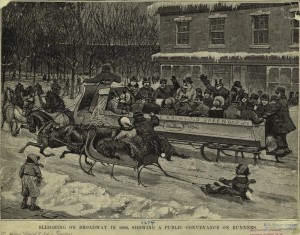
In mid-19th century New York, commuters relied on omnibuses — horse-drawn carriages that seated a dozen passengers, often many more, on wooden benches. (The driver stopped when passengers tugged on a strap attached to his ankle.) After a snow storm, carriages were replaced with sleighs.
In his diary, lawyer George Templeton Strong described commuter sleighs as “insane vehicles” that “carry each its hundred sufferers, of whom about half have to stand in the wet straw with their feet freezing and occasionally stamped on by their fellow travelers, their ears and noses tingling in the bitter wind, their hats always on the point of being blown off.”
The sleighs and sleds of snowy old New York, Ephemeral New York.
This Day in Tredwell Family History: Elizabeth Tredwell Dies
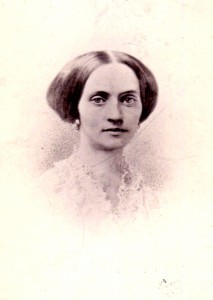 Elizabeth Seabury Tredwell, the eldest child of Eliza and Seabury Tredwell, was born on July 23, 1821, and died on January 7, 1880, at the age of 59. According to her death record, she died of “exhaustion and suffocation from chronic bronchitis.”
Elizabeth Seabury Tredwell, the eldest child of Eliza and Seabury Tredwell, was born on July 23, 1821, and died on January 7, 1880, at the age of 59. According to her death record, she died of “exhaustion and suffocation from chronic bronchitis.”
She married Effingham H. Nichols, a Yale alumnus (Class of 1841) and successful attorney, on April 19, 1845, at St. Bartholomew’s Church, then located around the corner from 4th Street at Great Jones Street and Lafayette Place. St. Bart’s was built in 1835 to accommodate the influx of new residents to the fashionable Bond Street neighborhood.
Following their marriage, the newlyweds lived with her parents in the 4th Street house, as was the custom. Their only child, Elizabeth Howard Nichols, known as Lillie, was born in 1854. (It was Lillie Nichols who inherited the house after her aunt Gertrude Tredwell died in 1933.)
In 1859, the family moved to Brooklyn, then to Fifth Avenue and 34th Street, across from William B. Astor, Jr. and John Jacob Astor, III.
According to Elizabeth’s obituary, published in The New York Times on January 11, 1880, “Relatives and friends of the family are respectfully invited to attend the funeral from her late residence, No. 339 5th av. on Monday, Jan. 12, at 10 o’clock A.M. Internment at Woodlaw Cemetery, by special train from the Grand Central Depot immediately after the service.”
Hurrah for the Pumpkin Pie!
by Merchant's House Museum
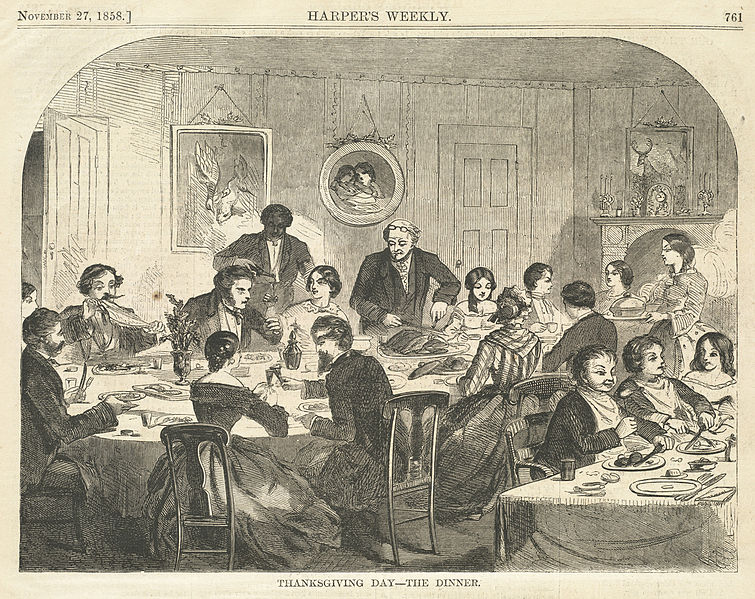
“Thanksgiving Day – The Dinner,” by Winslow Homer, Harper’s Weekly, November 27, 1858
In 1844, writer and reformer Lydia Maria Child wrote the classic Thanksgiving poem, A Boy’s Thanksgiving Day. The poem, later put to music and also revised as a Christmas song, celebrated her childhood memories of visiting her grandparents’ house in Massachusetts.
Over the river, and through the wood,
to Grandfather’s house we go;
the horse knows the way to carry the sleigh
through the white and drifted snow.
Over the river, and through the wood,
to Grandfather’s house away!
We would not stop for doll or top,
for ’tis Thanksgiving Day.
Over the river, and through the wood-
oh, how the wind does blow!
It stings the toes and bites the nose,
as over the ground we go.
Over the river, and through the wood
and straight through the barnyard gate.
We seem to go extremely slow-
it is so hard to wait!
Over the river, and through the wood-
when Grandmother sees us come,
She will say, “O, dear, the children are here,
bring a pie for every one.”
Over the river, and through the wood-
now Grandmothers cap I spy!
Hurrah for the fun! Is the pudding done?
Hurrah for the pumpkin pie!
At the time, Child was best known as the author of America’s first cookbook, The Frugal Housewife, which went through 35 printings between 1829 and 1850. Think Joy of Cooking, 19th century-style.
Here’s her recipe for Pumpkin Pie:
“For common family pumpkin pies, three eggs do very well to a quart of milk. Stew your pumpkin, and strain it through a sieve, or colander. Take out the seeds, and pare the pumpkin, or squash, before you stew it; but do not scrape the inside; the part nearest the seed is the sweetest part of the squash. Stir in the stewed pumpkin, till it is as thick as you can stir it round rapidly and easily. If you want to make your pie richer, make it thinner, and add another egg. One egg to a quart of milk makes very decent pies. Sweeten it to your taste, with molasses or sugar; some pumpkins require more sweetening than others. Two tea-spoonfuls of salt; two great spoonfuls of sifted cinnamon; one great spoonful of ginger. Ginger will answer very well alone for spice, if you use enough of it. The outside of a lemon grated in is nice. The more eggs, the better the pie; some put an egg to a gill of milk. They should bake from forty to fifty minutes, and even ten minutes longer, if very deep.”
“Fastidiously preserved” and “also imperiled” Merchant’s House in The NY Times
by Merchant's House Museum
Did you see the “fastidiously preserved” and “also imperiled” Merchant’s House in The New York Times last weekend?
Two Goods Reasons to Visit NoHo
From the 1830s to the 1850s, East Fourth Street was a high-society Manhattan address with neighbors named Astor and Vanderbilt. Charles Dickens and Washington Irving sojourned in the area, which then was called Bond Street. The MERCHANT’S HOUSE, at No. 29, built in 1832, stands as a testament to that period, seeming as unchanged and as fragile as Miss Havisham’s wedding dress. It is also imperiled.
Click here to read the full article.
Back to School with the Tredwells
by Merchant's House Museum

Classroom at Mrs. Okill’s Academy, drawn by a boarding student in 1850, when the Tredwell sisters were students.
The five older Tredwell girls were students at Mrs. Okill’s Academy, one of the most elite private female academies of the time. Located at 8-10 Clinton Street (now 8th Street), Mrs. Okill’s offered a “fashionable education” to young ladies. The school was housed in two connecting buildings each with a floor plan similar to that of the Merchant’s House. Here boarding students from as far away as Ohio and Louisiana joined day students like the Tredwells in the study of academic subjects, including the French language, as well musical training, considered an essential accomplishment of refined young ladies.
Our current special exhibition, Lessons Learned: The Tredwell Daughters’ Schoolbooks, is on display through Monday, September 29, and features rarely exhibited schoolbooks from the Museum’s collection, some bearing the comments and signature of Mrs. Okill herself.
Lookin’ Good, Mr. President
by Merchant's House Museum
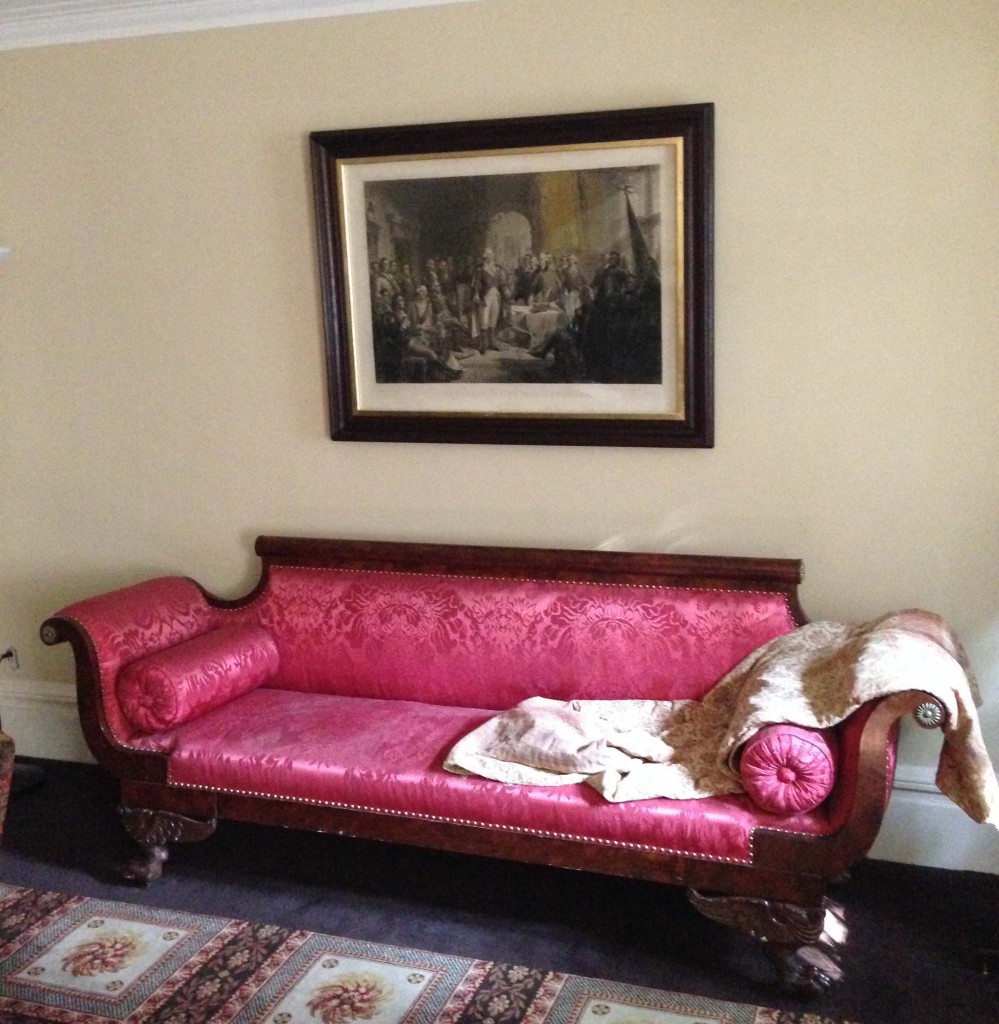
The Tredwells’ 1856 engraving, Washington and His Generals, once again on display in the ground floor Family Room
The 1856 Alexander Hay Ritchie engraving, Washington and His Generals, and its walnut and gilded frame returned to the Merchant’s House last week after six months of conservation. Paper Conservator Caroline Rieger cleaned the engraving, removed the acidic wood strainer, and mended old tears. Conservator Joseph Chiarello cleaned the frame, stabilized the corner joints, and restored the interior gilding. The engraving and frame looks (almost) as good as the day they were made and sold nearby on Broadway.
Washington’s image in 19th-century American homes was ubiquitous and the cultural ideals it represented make it essential to the story of a merchant family such as the Tredwells. Washington was ever on the mind of the Nation’s citizens with the celebration of his 100th birthday in 1832, construction on the Washington Monument in 1848, and efforts to restore his Viriginia home, Mount Vernon, in the 1850s. Many prints depicted Washington as a heroic leader, or as a domesticated family man, serving to make him inspirational to the average American. Seabury Tredwell was eight years old when Washington took the oath of office in New York City.
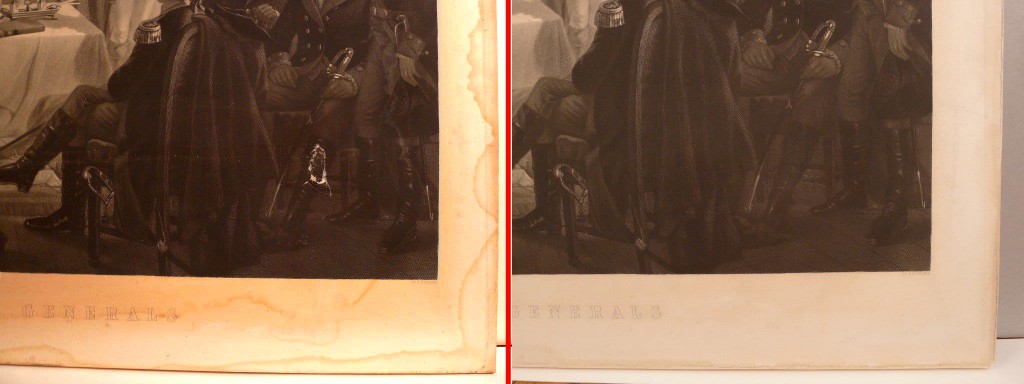
Detail of lower corner, before (left) and after conservation.
The conservation of the engraving and frame was made possible by The Conservation Treatment Grant Program of Greater Hudson Heritage Network with public funds from the New York State Council on the Arts, a state agency.
Older Posts »

